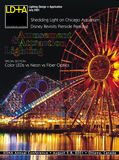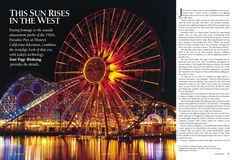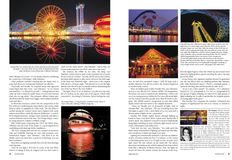


Paying homage to the seaside amusement parks of the 1920s, Paradise Pier, at Disney’s California Adventure, combines the nostalgic look of that era, with today’s technology.
Just because a lamp comes in a box and lights up doesn’t necessarily make it useful. In fact, according to one lighting designer, often, function can only be determined after a little abuse takes place.
“Don’t be afraid to make a fixture do what you want it to do. Take the lenses out; play with them,” says Michael Valentino, principal show lighting designer for Walt Disney Imagineering. “Know your tools and how they work. More importantly, know how to abuse them.”
Valentino’s office is a virtual torture chamber for unassuming lamps. Atop one desk, stray parts await crossbreeding while lamps that somehow fell short of their desired genetic mutation are displayed along a window ledge, their singed innards serving as an epitaph to what might have been. “Within any project there’s an infant mortality rate or the percentage of lamps that blow before they even have a chance,” he adds matter-of-factly.
Still, Valentino assures there is light at the end of every project. Such is the story of his latest project, Disney’s California Adventure (DCA) in Anaheim, CA, and the lighting triumph of Paradise Pier.
The new theme park, now part of the Disneyland Resort, showcases the best of the state of California, throughout six themed districts. The Paradise Pier district celebrates the seaside amusement parks that lined the California coast in the 1920s. The challenge for Valentino and fellow Imagineers: to recapture the romanticism and elegance of those parks without spilling into the realm of “carny.”
“To stay true to our story, we couldn’t just apply light to a bunch of attractions,” says Valentino. “What we did was paint a composition with the lighting. This means that the entire land ultimately worked as one entity. There wasn’t one dominant piece or even several parts that stood alone. We had to make everything ‘play’ together. And, looking at the final composition, it’s very gratifying.”
[…]